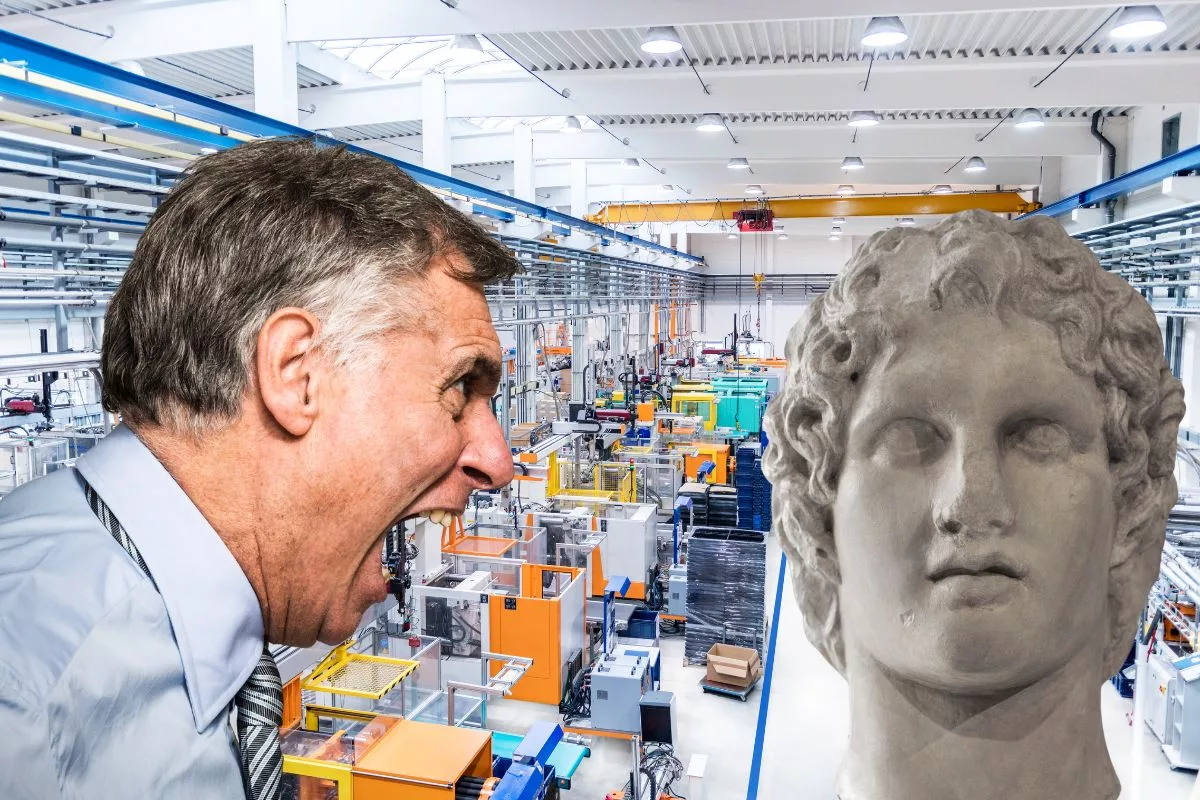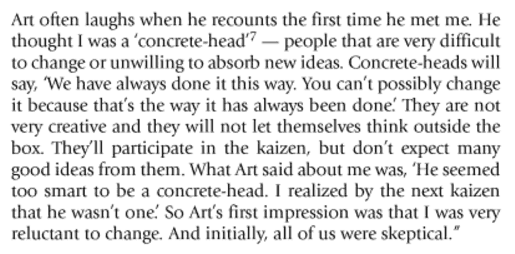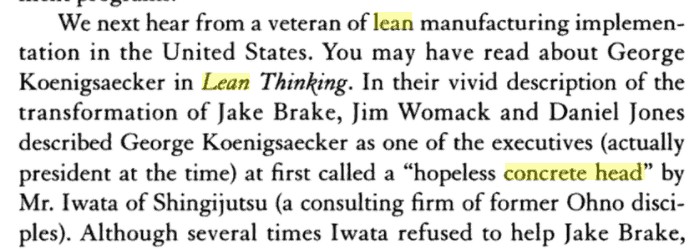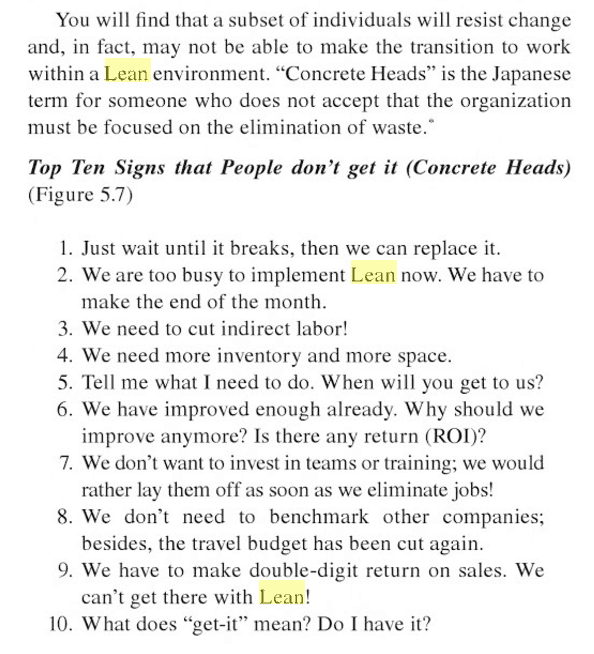This Post in <50 Words: When did the term “concrete head” start getting thrown around in some Lean circles? Do people still use this label today? Is it helpful? Should we agree that the term is disrespectful and counterproductive?
As somebody who writes and speaks a lot, I think words matter. Words can be helpful in our work, or they can get in the way or cause division.
In 2010, I wrote about 10 things I wish Lean practitioners would stop saying (and it's maybe still good advice in 2017):
One of those 10 words was the overuse of the word “sensei,” which I wrote about more recently:
Even the word “Lean” itself can be problematic, as Jim Womack himself reflected on here:
And, Lean people don't say “idiot proofing” anymore…
For a long time, I've run across the term “concrete head” in the Lean literature or I've heard it used in presentations… and I've never cared for it.
Hear Mark read this post — subscribe to Lean Blog Audio
On to “Concrete Heads”
I recently saw it in this article from IndustryWeek:
“Are ‘Concrete Heads' Wrecking Your Lean Manufacturing Efforts?“
The author, Larry Fast, wrote about the person asking about changing the mentality of managers:
“I don't know what role in the company this reader plays, but I'll address both questions since the root cause for both is the same. Your management are known as “concrete heads.” This is a term often used by Art Byrne, who led the transformation of Wiremold a few decades ago. These are so-called leaders who don't get “it,” don't want to get it and won't listen to those who do get it, understand it and simply need their “leaderships” support to go do it!”

As I commented on that article, I've never found it to be a good strategy to label people with negative terms like that. Once you call somebody a “concrete head,” aren't they more likely to dig in their heels? Does it thicken or harden the concrete further?
How does that affect your Lean transformation efforts? Does it help or hurt? I'd guess it probably hurts.
The term “concrete head” is used to describe somebody who is stubborn or resistant to change. It doesn't mean they are dumb. The term often gets pointed at senior leaders (although probably not said to their face unless it's a really powerful consultant).
Even if it's true, does the phrase help? What does it accomplish? Does it make us feel better for being more enlightened than them? If so, how does that really help?
Is the term respectful, in the context of the “respect for people” principle of Toyota?
Is “concrete head,” like “sensei,” a term that one should only give to themselves, as in “I used to be a real concrete head,” as said in a self-deprecating way?
My friend Mike Wroblewski wrote something to this effect about himself:
“Confessions of a recovering concrete head“
He wrote, in part:
“We had a top-tier Japanese consultant acting as our sensei for the event with a huge scoped project, impossible target goals and a looming Friday deadline. The week was filled with a flurry of activities and constant motivating (yelling) guidance from our never-gives-a-compliment consultant. Getting yelled at in Japanese is a unique cultural experience all to its own, plus you get the English version from a translator, only without the emotion. My bet was that the translation was probably kinder in word than the actually Japanese meaning. It was almost funny if it wasn't for the public pronouncement to my team members that I was a concrete head.
Me? A concrete head? I have been called plenty of names before but never a concrete head. For those of you new to lean, a concrete head is someone who is hard-headed and not open-minded. It is a term given to those of us who questioned these new approaches to manufacturing.”
Is “concrete head” a term that TPS innovators like Taiichi Ohno or Shigeo Shingo used as part of a different era where yelling and screaming were more accepted?
I did my best to do a literature search on the phrase via a Google Books search and an Amazon search.
I can't find any references to this term in books by or about Ohno and Shingo.
I don't think the term appeared in the first “Lean” book, The Machine That Changed the World,” as there are only references to “concrete examples.”
The later book from Womack and Jones, Lean Thinking, had a reference to Pat Lancaster, founder and CEO of Lantech, calling himself that:

Tomorrow, I'm doing a podcast interview with the current CEO, Pat's son, Jim Lancaster, about Lantech's Lean journey and Jim's new book, The Work of Management (published by Womack's Lean Enterprise Institute).
In Lean Thinking, Art Byrne (hear my podcast with him) uses the term:

Did Art learn the term from his mentors from Shingijutsu?
Jeff Hajek, on his Lean site, says the term “concrete head” is the result of translation from Japanese consultants (I've sometimes heard the term “insultant” used, sometimes warmly by those who have suffered under such insults).
Jeff writes:
“In working with Japanese consultants, it appeared that the term was applied to individuals who displayed resistance, but was used matter-of-factly. It did not seem to carry the same negative charge that it does in its English translation.”
He says, “Obviously this is a derogatory term” and that it “displays a lack of respect for people, and it should be avoided.” I agree.
Bob Emiliani Knows the Origin
Bob Emiliani said similar things in a blog comment:
“…In the past, we were taught by our sensei that people who resisted change were “concrete heads” and there was not much we could do about it. Now we have a better approach for dealing with resistance that will improve the probability of favorable outcomes (i.e. engagement with Lean principles and practices). And, importantly, it changes the nature of resistance from being a people problem to a process problem.
…
The way the term “concrete head” was represented to me by my senseis was as a fact, not as derogatory or disrespectful. That nuance sometimes gets lost in translation.
I understood it as the name given to a problem (people unwilling to accept new ideas), that required more attention on the part of management. It represented both a management challenge to get people to accept new ideas or (eventually) part ways with those who won't. Also, it informed management of who NOT to put in leadership positions, because they will undermine Lean transformation efforts.
The origins of the term are described in Note 7 on page 178 of Better Thinking, Better Results.”
That note reads (click for a larger view or buy the book):

It sounds like Art threw that term at others after learning it, as it says in Bob's book, in a story told by somebody else about him and Art:

Jeff's advice about dealing with so-called “concrete heads” is similar to things I've written before:
“It implies that there is no reason for a person's resistance to change other than that a person is inflexible. In truth, when people push back against new ideas, it is for a reason. Uncover that reason and address it, and the person will no longer be in the “concrete head” category.”
Jeff Liker's book Becoming Lean (a book I bought in 1998), conveys a story about the legendary George Koenigsaecker (who has advised many, including Dr. John Toussaint and others in healthcare)… he was called a “hopeless concrete head” by Shingijutsu:

I'm not going to try to tell the accomplished Shingijutsu consultants how to do their jobs. But I'm not going to emulate their use of the term “concrete head,” and I'd hope others would follow.
Has the Term Spread?
This term has even been brought into healthcare by people from manufacturing, including Charlie Protzman (who I respect greatly and learned a lot from while I was at J&J ten years ago). In one of his books (one not focused on healthcare) at least talks about the need to convert a “concrete head” into a “Lean believer” (which is better than just labeling and giving up):

At least Charlie preaches patience, questions, and empathy (better engagement strategies than insults).
He uses the term in his healthcare books:

The term has even crept into “Lean software:”

Don't be a Concrete Head About Saying “Concrete Head”
Although, I'm not sure it's meant the same way here. I think it's just a general synonym for “hard-headed?”
Either way, I don't use the term. I don't like to label people as “resistant to change.” We have to work with them… it's a process and a journey. We can't expect people to stop on a dime, throw away decades of experience in thinking, and suddenly start doing things another way.
What do you think?
Please scroll down (or click) to post a comment. Connect with me on LinkedIn.
Let’s work together to build a culture of continuous improvement and psychological safety. If you're a leader looking to create lasting change—not just projects—I help organizations:
- Engage people at all levels in sustainable improvement
- Shift from fear of mistakes to learning from them
- Apply Lean thinking in practical, people-centered ways
Interested in coaching or a keynote talk? Let’s start a conversation.





![When Was the Last Time a Leader Around You Admitted They Were Wrong? [Poll]](https://www.leanblog.org/wp-content/uploads/2025/07/Lean-Blog-Post-Cover-Image-2025-07-01T212509.843-238x178.jpg)




Comments from LinkedIn:
Glenn Edwards
It seems to me, when we resort to name calling and labeling, we have not done enough to resolve concerns and get to the root cause – whether that be process related or people related.
john liguori
I believe your thoughts are still relevant today as they were in 2010. I enjoyed reading this article
Marvin Kessler
Name calling never leads to progress. Thanks for another good article Mark.
Mike Santarelli
Some sensei believe this is a form of tough love that when applied carefully will help a person dig deep to become a better problem-solver. The idea is described in “Shingijutsu-Kaizen” (Emiliani”) and, in a way, a form of respect in that the sensei is demanding of you because they know you can be much better …
and I replied to Mike:
The Sensei might believe that, but they should be careful. That won’t be received well on this day
I believe you’ve missed the entire point of my Industry Week article. In spite of all the “shock/disapproval” around my quoting of the phrase “concrete heads”, made famous by one of the early pioneers of transforming businesses before there was such a thing as lean, here’s more of the thinking in a shorter version:
Why is it that only 5% or so start their lean journey and sustain their journey to excellence beyond 10 years? In spite of all the rhetoric and noise about it, this number hasn’t materially changed over the last 30 years. My conclusion: This is evidence of the greatest leadership failure in the history of CI that dates back to the TQM and JIT days in the 1980s. I also firmly believe that the engaged culture that we seek will only sustain if senior leaders support, (and their successors) understand, think, work and behave differently themselves. Unfortunately, that’s a rare thing to behold over my 45 years in manufacturing, 35 of which were actually in the arena at a senior level. I reported to 5 CEO/Presidents. Two were knowledgeable and highly supportive and engaged. Three were obstacles and cared about nothing but next quarter’s stock price. Because of my position, the Operations team did a great job executing our CI strategy in manufacturing in spite of them, but other functional areas, with few exceptions, engaged. A handful of zealots simply can’t change leaders that don’t support CI, don’t want to change or only give lip service. In those cases their associates are far better off seeking a company that supports their values and their ambitions to achieve and sustain excellence. Life’s too short to spend a career frustrated trying to push ropes and totally unappreciated. Leadership who creates obstacles instead of helping to eliminate them doesn’t deserve respect that most feel entitled to. In my world, respect has to be earned. I’m sure Art Byrne understands this fully.
Larry E. Fast
Founder & President,
Pathways to Manufacturing Excellence
Coach, Consultant and Author
What you say makes sense, Larry. But I think you missed the point of my post. For everything you describe, does calling them or referring to them as “concrete head” increase anybody’s rate of success? I don’t blame you for that term being out there.